GIGABYTE GV-N285-1GH-B, GV-N285UD-1GH Owner's Manual
GV-N285-1GH-B/ GV-N285UD-1GH
NVIDIA® GeForceTM GTX 285 Graphics Accelerator
User's Manual
Rev. 102
12MM-N285GB-102R
Copyright
© 2009 GIGABYTE TECHNOLOGY CO., LTD
Copyright by GIGA-BYTE TECHNOLOGY CO., LTD. ("GBT"). No part of this manual may be reproduced or transmitted in any form without the expressed, written permission of GBT.
Trademarks
Third-party brands and names are the properties of their respective owners.
Notice
Please do not remove any labels on this graphics card. Doing so may void the warranty of this card.
Due to rapid change in technology, some of the specifications might be out of date before publication of this this manual. The author assumes no responsibility for any errors or omissions that may appear in this document nor does the author make a commitment to update the information contained herein.
Macrovision corporation product notice:
This product incorporates copyright protection technology that is protected by U.S. patents and other intellectual property rights. Use of this copyright protection technology must be authorized by Rovi Corporation, and is intended for home and other limited viewing uses only unless otherwise authorized by Rovi Corporation. Reverse engineering or disassembly is prohibited.
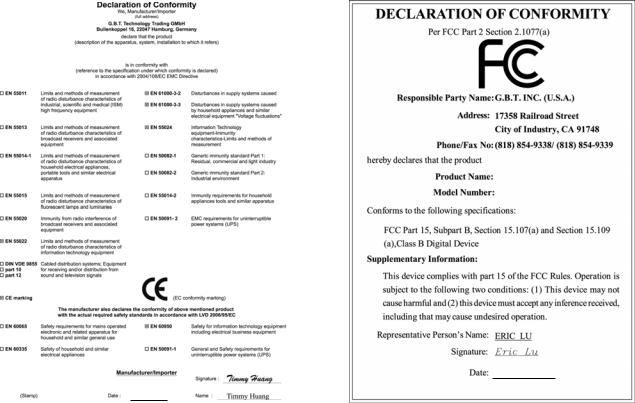
VGA Card
GV-N285-1GH-B
VGA Card
GV-N285-1GH-B
Jan. 08, 2009
Jan. 08, 2009

VGA Card
GV-N285UD-1GH
VGA Card
GV-N285UD-1GH
Apr.16, 2009
Apr. 16, 2009

Table of Contents |
|
1. Introduction ................................................................................................................ |
5 |
1.1. Features ......................................................................................................................... |
5 |
1.2. Minimum System Requirements .................................................................................... |
5 |
2. Hardware Installation .................................................................................................. |
6 |
2.1. Board Layout ................................................................................................................. |
6 |
2.2. Hardware Installation .................................................................................................... |
10 |
3. Software Installation .................................................................................................. |
14 |
3.1. Windows® XP Driver and Utilities Installation .............................................................. |
14 |
3.1.1. Operating System Requirements .............................................................................. |
14 |
3.1.2. DirectX Installation ........................................................................................................ |
15 |
3.1.3. Driver Installation ......................................................................................................... |
16 |
3.1.4. GIGABYTE Gamer HUD Lite on Driver Disk ........................................................... |
18 |
3.1.5. Taskbar Icon ................................................................................................................. |
20 |
3.1.6. Display Properties Pages ........................................................................................... |
21 |
3.1.7 nView Properties Pages (Note) ................................................................................. |
32 |
4. Troubleshooting Tips ................................................................................................ |
37 |
5. Appendix ................................................................................................................. |
38 |
5.1. How to Reflash the BIOS in MS-DOS Mode .............................................................. |
38 |
5.2. Resolutions and Color Depth Table (In Windows XP) ................................................... |
39 |
5.3. Regulatory Statements ................................................................................................. |
41 |
(Note) This item will show up when you connect two monitors.
- 4 -

1. Introduction
1.1.Features
•Powered by NVIDIA® GeForceTM GTX 285 Graphics Processing Unit (GPU)
•Supports PCI Express 2.0
•Integrated with 1 GB GDDR3 memory
•Supports DirectX 10
•Supports NVIDIA® SLI TM (Scalable Link Interface) technology (Note 1)
•Supports 2 Dual-Link DVI-I connectors
•Supports 1 HDMI connector (by optional adapter)
•Supports 1 D-Sub connectors (by adapter)
•Supports HDCP (High-Bandwidth Digital Content Protection) technology
1.2.Minimum System Requirements
•Hardware
-550-watt system power supply specification or above is recommended.
-Intel® Pentium® 4 or AMD AthlonTM XP class
-1 GB of system memory; 2 GB or more for best performance
-Optical drive for software installation (CD-ROM or DVD-ROM drive)
•Operating System
-Windows® Vista
-Windows® XP with Service Pack 2 (SP2)
-Windows® XP Professional x64 Edition
•SLI TM Configuration
If you are planning on using this graphics card as part of an SLI system, the following are required:
-An SLI certified motherboard with two/three PCIe x16 slots and correct chipset driver
-Two GV-N285-1GH-B /GV-N285UD-1GH for SLI configuration; Three GV-N285-1GH-B/GV-N285UD-1GH for 3-way SLI configuration
-A power supply with 900-watt or above is recommended
-An SLI bridge connector or 3-way SLI bridge connector
(Note 1) SLI technology requires a PCI Express motherboard with two/three x16 physical connectors. Graphics cards working in an SLI configuration must be with the same model name
(e.g. GV-N285-1GH-B/GV-N285UD-1GH) and from the same vendor (e.g. GIGABYTE TECHNOLOGY).
- 5 - |
Introduction |
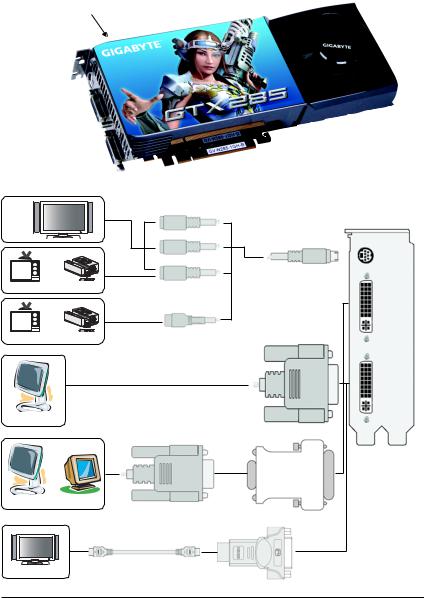
2. Hardware Installation
2.1. Board Layout
1. GV-N285-1GH-B
SLI Connector
TV-Out
DVI-I Connector 1
DVI-I Connector 2 |
|
||
HDTV |
Y |
|
|
|
|
||
|
Pr |
(optional) |
|
or |
Pb/AV Output |
|
|
|
|
||
NTSC / PAL TV |
Projector |
|
|
|
S-Video Output |
|
|
or |
|
|
|
NTSC / PAL TV |
Projector |
|
|
|
DVI Output |
|
|
Digital LCD Monitor |
|
|
|
or |
D-Sub |
DVI-I to D-Sub |
|
Output |
Adapter |
||
|
|||
Analog LCD Monitor |
Analog Monitor |
|
|
HDMI TV
DVI-I to HDMI Adapter
TV-Out
DVI-I
Connector 1
DVI-I
Connector 2
GV-N285 Series Graphics Accelerator |
- 6 - |
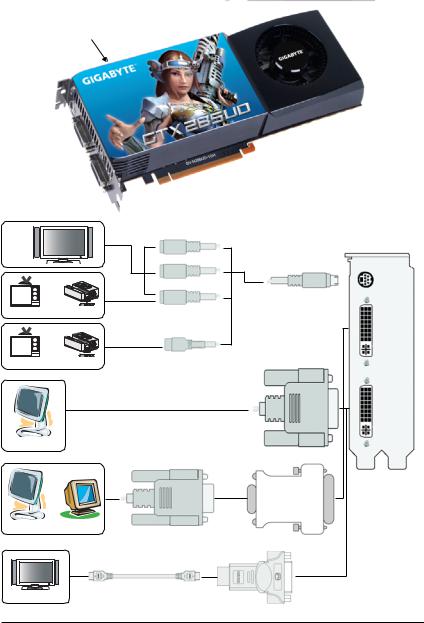
2. GV-N285UD-1GH
SLI Connector
TV-Out
DVI-I Connector 1
DVI-I Connector 2
HDTV |
Y |
|
|
|
|
||
|
Pr |
(optional) |
|
|
|
||
or |
Pb/AV Output |
|
|
|
|
||
NTSC / PAL TV |
Projector |
|
|
|
S-Video Output |
|
|
or |
|
|
|
NTSC / PAL TV |
Projector |
|
|
|
DVI Output |
|
|
Digital LCD Monitor |
|
|
|
or |
D-Sub |
DVI-I to D-Sub |
|
Output |
Adapter |
||
|
|||
Analog LCD Monitor |
Analog Monitor |
|
HDMI TV
DVI-I to HDMI Adapter (optional)
TV-Out
DVI-I
Connector 1
DVI-I
Connector 2
- 7 - |
Hardware Installation |
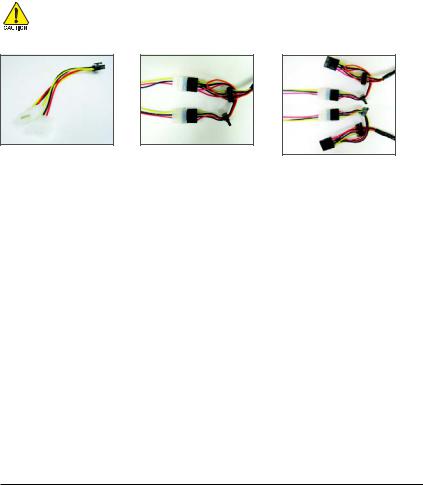
The GV-N285-1GH-B/GV-N285UD-1GH graphics card is a performance optimized high-end card. Power is taken from the PCI Express host bus as well as the two 6-pin PCI Express power connectors. Without auxiliary power provided to the GV-N285-1GH-B/GV-N285UD-1GH graphics card, an LED on the bracket goes red and the graphics card will not boot. In addition, the connector that is not adequately powered will turn red.
The table below outlines the different possible scenarios as well as the resulting behaviors. Configuration with External PCIe Connectors:
6-pin PCIe Power |
6-pin PCIe Power |
Result |
|
Connector (upper) |
Connector (lower) |
||
|
|||
Connected |
Connected |
Full Power |
|
Not Connected |
Connected |
LED light is redgraphics card will not boot |
|
Connected |
Not Connected |
LED light is redgraphics card will not boot |
|
Not Connected |
Not Connected |
LED light is redgraphics card will not boot |
If you want to use the included 6-pin power adapters, make sure the adapter fits 12V/15A specification. Failure to do so may jeopardize the stability of the graphics card.
6-pin Power
Adapter
Incorrect Connection
(The two 4-pin power connectors on the adapter are connected to the same system power supply cable.)
Correct Connection
(The two 4-pin power connectors on the adapter are connected to two independent system power supply cables.)
GV-N285 Series Graphics Accelerator |
- 8 - |

Expansion cards contain very delicate Integrated Circuit (IC) chips. To protect them against damage from static electricity, you should follow some precautions whenever you work on your computer.
1.Turn off your computer and unplug power supply.
2.Use a grounded wrist strap before handling computer components. If you do not have one, touch both of your hands to a safely grounded object or to a metal object, such as the power supply case.
3.Place components on a grounded antistatic pad or on the bag that came with the components whenever the components are separated from the system.
The card contains sensitive electric components, which can be easily damaged by static electricity, so the card should be left in its original packing until it is installed.
Unpacking and installation should be done on a grounded anti-static mat. The operator should be wearing an anti-static wristband, grounded at the same point as the anti-static mat.
Inspect the card carton for obvious damage. Shipping and handling may cause damage to your card. Be sure there are no shipping and handling damages on the card before proceeding.
 DO NOT APPLY POWER TO YOUR SYSTEM IF THE GRAPHICS CARD IS DAMAGED.
DO NOT APPLY POWER TO YOUR SYSTEM IF THE GRAPHICS CARD IS DAMAGED.
 In order to ensure that your graphics card can work correctly, please use official GIGABYTE BIOS only. Using non-official GIGABYTE BIOS might cause problem(s) on the graphics card.
In order to ensure that your graphics card can work correctly, please use official GIGABYTE BIOS only. Using non-official GIGABYTE BIOS might cause problem(s) on the graphics card.
- 9 - |
Hardware Installation |

2.2. Hardware Installation
Now that you have prepared your computer, you are ready to install your graphics card.
Step 1.
Locate the PCI Express x16 slot. If necessary, remove the metal cover from this slot; then align your graphics card with the PCI Express x16 slot, and press it in firmly until the card is fully seated.
Make sure that the gold edge connector of the graphics card is securely inserted.
Step 2.
Replace the screw to fasten the card in place, and replace the computer cover.
After installation, remember to connect the power cable to your graphics card, or the system will not boot (refer to page 6 to see the details). Do not touch the card when it's operating to prevent system instability.
Step 3.
This graphics card provides two DVI-I digital connectors. You can connect a monitor that supports DVI-I function or use the DVI-I to D-Sub adapter to connect a 15-pin D-Sub monitor. Or use the DVI-I to HDMI adapter to connect an HDMI monitor.
Connect a flat panel
To TV / VCR |
To Flat Panel Display |
ConnectaD-SubmonitorviaDVI-ItoD-Subadapter |
ConnectaHDMImonitorviaDVI-ItoHDMIadapter
GV-N285 Series Graphics Accelerator |
- 10 - |

Step 4.
To connect an HDMI TV, use either Method A or Method B below (depending on your motherboard design) to enable the S/PDIF in function for the graphics card. It is recommended Method A be used on motherboards that have a free S/PDIF header.
Method A (via the S/PDIF out header):
Connect the provided S/PDIF cable to the graphics card and the S/PDIF out header on your motherboard (the red wire connects to the S/PDIF out pin and the black to the Ground pin).
A-1. |
A-2. |
Connect the S/PDIF cable to the graphics card |
Connect the S/PDIF cable to the motherboard. |
- 11 - |
Hardware Installation |

GIGABYTE Video Adapter (optional item)
S-Video Out
Connect to the TV-Out port on the graphics card.
AV Out
HDTV Component (Y+Pr+Pb)
(1) Connecting HDTV
Connect your HDTV cables to the video adapter according to the corresponding color.
(Y= Green, Pr= Red, Pb= Blue)
(2) Connecting S-Video
If your TV has a S-Video connection, connect the S-Video cable from your TV to the S-Video Out port on the adapter.
(3) Connecting AV Output
If your TV has a Composite video connection, you can connect the RCA cable from your TV to the AV Out port on the adapter.
GV-N285 Series Graphics Accelerator |
- 12 - |
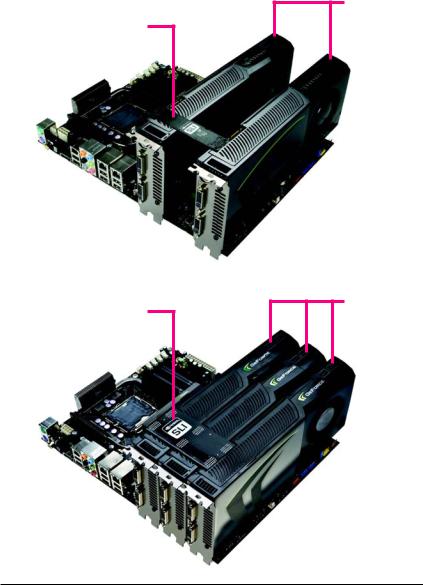
How NVIDIA® SLITM (Scalable Link Interface) technology works:
In an SLI configuration, two/three SLI-ready graphics cards of the same model and the same manufacturers are connected together via SLI bridge connector in a system that provides two/three x16 PCI Express slots to scale graphics performance. The picture below shows that two and three graphics cards are linked in parallel in an SLI configuration.
SLI Configuration:
SLI bridge connector (provided by motherboard manufacturer)
Two SLI-ready graphics cards of the same type. (Example:
GV-N28-1GH-B)
3-Way SLI Configuration:
3-Way SLI bridge connector (provided by motherboard manufacturer)
Three SLI-ready graphics cards of the same type. (Example:
GV-N28-1GH-B)
- 13 - |
Hardware Installation |

3. Software Installation
In this manual, we assume that your CD-ROM drive letter to be Drive D:
The installation of drivers is very simple. When you insert the driver CD into your CD-ROM drive, you can see the autorun window (if it does not show up, run "D:\setup.exe"). Then you can follow the instructions to setup your graphics card driver. (Please follow the subsection "3.1.3 Driver Installation" to install the driver for your graphics card.)
3.1. Windows® XP Driver and Utilities Installation
3.1.1. Operating System Requirements
Notice the following guidelines before installing the drivers:
1. First make sure your system has installed DirectX 9.0c or later version.
2. Make sure your system has installed the appropriate motherboard drivers (for the motherboard drivers, please contact the motherboard manufacturer.)
GV-N285 Series Graphics Accelerator |
- 14 - |
